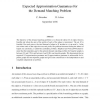Free Online Productivity Tools
i2Speak
i2Symbol
i2OCR
iTex2Img
iWeb2Print
iWeb2Shot
i2Type
iPdf2Split
iPdf2Merge
i2Bopomofo
i2Arabic
i2Style
i2Image
i2PDF
iLatex2Rtf
Sci2ools
MOR
2007
2007
The Demand-Matching Problem
The objective of the demand matching problem is to obtain the subset M of edges which is feasible and where the sum of the profits of each of the edges is maximized. The set M is feasible if for each vertex v the total demand of edges in M incident to v is at most bv. In the case where each of the edges has one unit profit, the problem becomes finding the subset of largest size and hence, is called the cardinality problem. Shepherd and Vetta [SV06] demonstrate that the integrality gap for the general demand matching problem for bipartite graphs is between 2:5 and 2:764, and between 3 and 3:264 non-bipartite graphs. We demonstrate that an expected 2:5-approximation guarantee and 3-approximation guarantee is achieveable for bipartite graphs and non-bipartite graphs and give some connections to the independent set and weighted independent set problem.
| Added | 27 Dec 2010 |
| Updated | 27 Dec 2010 |
| Type | Journal |
| Year | 2007 |
| Where | MOR |
| Authors | F. Bruce Shepherd, Adrian Vetta |
Comments (0)

